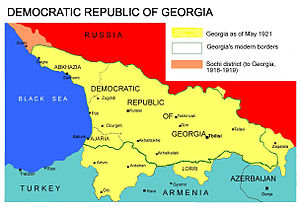Georgian-Armenian War
| Georgian–Armenian War | |||||||||
|---|---|---|---|---|---|---|---|---|---|
| Part of the aftermath of World War I | |||||||||
 |
|||||||||
|
|||||||||
| Belligerents | |||||||||
|
|
|
||||||||
| Commanders and leaders | |||||||||
| Drastamat Kanayan |
Giorgi Mazniashvili Giorgi Kvinitadze Valiko Jugheli |
||||||||
| Strength | |||||||||
|
In Lori: initially 4,000 in total incl. partisans or 28 infantry companies and 4 cavalry squadrons excl. partisans. 6,500 troops at peak, supported by local rebels. In Akhalkalaki: probably much fewer. |
In Lori: several hundred initially incl. German troops. Gradually increasing. More than 3,500 National Guard and People's Guard troops during the final stages of the war. In Akhalkalaki: over 6,000. |
||||||||
| Casualties and losses | |||||||||
| hundreds killed, wounded or taken prisoner. 1610 taken prisoner according to government of Georgian DR |
hundreds killed, wounded or taken prisoner. About 1000 taken prisoner according to Hovannisian |
||||||||
| total death toll may range in the thousands. | |||||||||
The Georgian–Armenian War was a short border dispute fought in December 1918 between the newly-independent Democratic Republic of Georgia and the First Republic of Armenia, largely over the control of territories in Lori and Kvemo Kartli districts.
In March 1918, Russian signed the Treaty of Brest-Litovsk and in doing so agreed to return to the Ottoman Empire territory gained during the 1877–78 Russo-Turkish War. These territories were, however, no longer under the functional control of the Russian central government; rather, they were being administered collectively by the Georgians, Armenians and Azerbaijanis through the Transcaucasian Sejm. The Trebizond Peace Conference aimed to resolve the dispute, but when the conference failed to produce a resolution, the Ottomans pursued a military campaign to control the disputed territories. Under persistent attack, the Transcaucasians collective eventually dissolved with the Georgians, Armenians and Azerbaijanis declaring independent nation states in quick succession in late-May 1918. On 4 June, the Ottoman Empire signed the Treaty of Batum with each of the three Transcaucasus states, which brought the conflict to an end and awarded the southern half of the ethnically-Armenia Lori Province and Akhalkalaki district to the Ottomans. Against the wishes of Armenia, Georgia, supported by German officers, took possession of northern Lori and established military outposts along the Dzoraget River.
When the Ottomans signed the Armistice of Mudros in October, they were subsequently required to withdraw from the region. Armenia quickly took control of territory previously controlled by the Ottomans, and skirmishes between the Armenia and Georgia arose starting on 18 October. Open warfare began in early December, after diplomatic efforts failed to resolve the issue of the disputed border, and continued until 31 December, when a British-brokered ceasefire was signed, leaving the disputed territory under joint Georgian and Armenian administration.
...
Wikipedia
